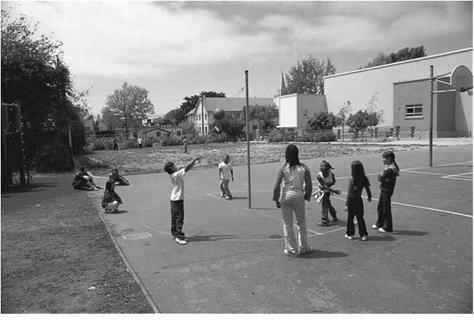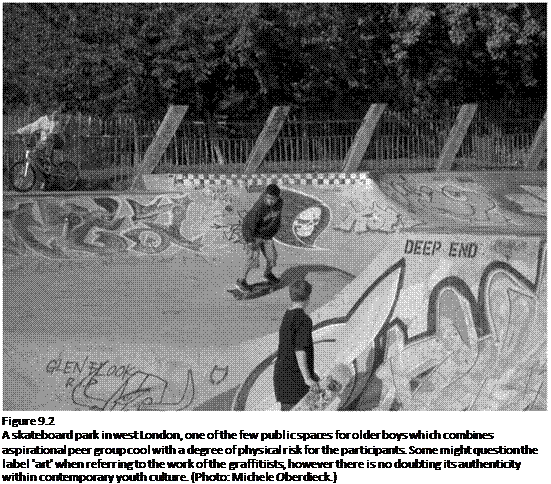Helen Penn
 |
 |
Editor’s introduction
In this chapter Professor Helen Penn discusses the issue of children and their presence within the public domain. What is the public domain?
In this context it can be defined as the shops, restaurants, airports, railway stations and other public areas which are distinct from the private territory of the family, the home, the motor car or dedicated institutions for children such as the
school or the daycare centre where children are supervised and become the responsibility of adult carers, parents and relatives.
Here she makes the point that many of what might be termed the new public domain are places which are predicated upon commercial expediency. She recognizes that there is also a non-commercial, more traditional public domain. In this we might include public parks, streets, sports centres, the countryside which is accessible, the National
Parks within the UK and perhaps most interesting, left over wasteland in and around our cities heartlands.
She raises concerns about the limited opportunities that children have to spend time without the immediate controlling presence of adult relatives or paid carers. She compares the contemporary condition of children, confined and restricted in an anti-social environment, with historical accounts of children’s play in the public domain. In the past children appear to be active outdoor creatures engrossed in collective and group activities play and socialization which is selfgenerated, relying on imagination and inventiveness. In contrast, a contemporary view of childhood groups within the public domain is one where
children are anti-social criminals. It is only when children are supervised and properly controlled that they are acceptable.
These two views are perhaps extreme, however one suspects that the author’s view is one which genuinely laments the lack of children to be seen in the public domain. They are, as she says, becoming an endangered species like the skylark. As for interaction with them, fear of strangers and abduction makes this virtually impossible.
 |
In some senses her view is harking back to a simpler time, but she raises some important issues about how we should design our urban spaces. Her’s is a radical view which encourages the mingling of adults and children in public places as essentially civilizing. She asks us to consider the
places we design for children’s unsupervised activities, such as parks and streets, to be more child orientated. Safety, she believes, should not be the only criteria, rather a more balanced view about the public domain should be struck which respects the aspirations of children to be independent.
Introduction
One of the most significant changes in the urban landscape over the last century has been the disappearance of children. In industrialized societies children are literally disappearing. Families are much smaller and, except amongst certain minority groups, the birth rate has fallen to below replacement levels. But children have also disappeared from public view. Pictures, postcards and photos of urban life a century ago invariably included children of all ages. Now they have vanished from public spaces. Like the skylark – perhaps not so far-fetched an analogy – they have become endangered. The pleasure in watching their unselfconscious and exuberant games, or even the annoyance caused by their chasing, taunting and throwing balls, is no longer to be had. Children are literally perceived to be ‘in danger’ outside of their immediate domestic space; and to ‘be dangerous’ to others if they roam unattended. Compare this with the account by John Muir of his childhood in a small industrial Scottish town outside Edinburgh in the 1840s:
Among our best games were running, jumping, wrestling and scrambling… our most exciting sport however was playing with gunpowder. We made guns out of gas pipe, mounted them on sticks of any shape, clubbed our pennies together for powder, gleaned pieces of lead here and there, cut them into slugs, and, while one aimed, another applied a match to the touch-hole. With these awful weapons we fired at the gulls and solan-geese as they passed us. Fortunately we never hurt any of them that we knew of. We also dug holes in the ground, put in a handful or two of powder, tamped it well down around a fuse made of a wheat-stalk, and reaching cautiously forward, touched a match to the straw. This we called making earthquakes… Another favourite sport was climbing trees and scaling garden walls. Boys eight or ten years of age could get over almost any wall by standing on each others’ shoulders, thus making living ladders. To make walls secure against marauders, many of them were finished on top with broken bottles imbedded in lime, leaving the cutting edges sticking up; but with bunches of grass and weeds we could sit or stand in comfort on top of the jaggedest of them. In the winter, when there was but little doing. we organized running-matches. A dozen or so of us would start out on races that were simply tests of endurance, running on and on along a public road over the breezy hills like hounds, without stopping or getting tired. we thought nothing of running right ahead ten or a dozen miles before turning back.1
John Muir, who became a great American naturalist, is reckoned to be a reliable observer, despite his Arcadian leanings. He probably did not exaggerate his childhood overmuch in the retelling. Such childhoods are unimaginable and intolerable now. We do not expect children to be so adventurous or imaginative or expose themselves to danger in this way. If they did, we would consider them disturbed and seriously in need of correction and restraint, over and above the occasional thrashing that John Muir endured. We cannot conceive of such levels of activity in relatively young children, unless they were being cruelly trained as part of a relentlessly ambitious sports programme. Gangs of young boys, or any kind of voluntary and adultless association of children are also perceived to be subversive, a threat of trouble and disturbance to the social order. John Muir and his friends would have no place whatsoever in a contemporary urban setting.



